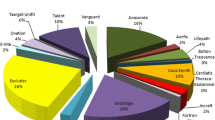Abstract
Purpose
The principal anatomic contraindication to endovascular aneurysm repair (EVR) is an unfavorable proximal aortic neck. With increasing experience, a greater proportion of patients with unfavorable neck anatomy are being offered EVR. This study aimed to evaluate outcomes in patients with challenging proximal aortic neck anatomy.
Methods
Prospectively collected data from 147 consecutive patients who underwent EVR between December 1997 and April 2005 were supplemented with a retrospective review of medical records and radiological images. Unfavorable anatomic features were defined as neck diameter >28 mm, angulation >60°, circumferential thrombus >50%, and length <10 mm. Eighty-seven patients with 0 adverse features (good necks) were compared with 60 patients with one or more adverse features (hostile necks).
Results
Comparing the good neck with the hostile neck group, there were no significant differences in the incidence of primary technical success (p = 0.15), intraoperative adjunctive procedures (p = 0.22), early proximal type I endoleak (<30 days) (p = 1.0), late proximal type I endoleak (>30 days) (p = 0.57), distal type I endoleak (p = 0.40), type III endoleak (p = 0.51), secondary interventions (p = 1.0), aneurysm sac expansion (p = 0.44), or 30 day mortality (p = 0.70). The good neck group had a significantly increased incidence of type II endoleak (p = 0.023). By multivariate analysis, the incidence of intraoperative adjunctive procedures was significantly increased in the presence of severe angulation (p = 0.041, OR 3.08, 95% CI 1.05–9.04).
Conclusion
Patients with severely hostile proximal aortic neck anatomy may be treated with EVR, although severely angulated necks require additional intraoperative procedures. Early outcomes are encouraging and suggest that indications for EVR may be expanded to include patients with hostile neck anatomy.


Similar content being viewed by others
References
Rimon U, Garniek A, Golan G, et al. (2004) Resolved abdominal aortic aneurysms following stent-graft treatment: A report of five cases. Cardiovasc Intervent Radiol 27:143–14
Ouriel K, Tanquilut E, Greenberg RK, et al. (2003) Aortoiliac morphologic correlations in aneurysms undergoing endovascular repair. J Vasc Surg 38:323–328
Arko FR, Filis KA, Seidel SA, et al. (2004) How many patients with infrarenal aneurysms are candidates for endovascular repair? The Northern California experience. J Endovasc Ther 11:33–40
Hovsepian DM, Hein AN, Pilgram TK, et al. (2001) Endovascular abdominal aortic aneurysm repair in 144 patients: Correlation of aneurysm size, proximal aortic neck length, and procedure-related complications. J Vasc Interv Radiol 12:1373–1382
Mohan IV, Laheij RJ, Harris PL (2001) Risk factors for endoleak and the evidence for stent-graft oversizing in patients undergoing endovascular aneurysm repair. Eur J Vasc Endovasc Surg 21:344–349
Stanley BM, Semmens JB, Mai Q, et al. (2001) Evaluation of patient selection guidelines for endoluminal AAA repair with the Zenith Stent-Graft: The Australasian experience. J Endovasc Ther 8:457–464
Sternbergh WC III, Carter G, York JW, et al. (2002) Aortic neck angulation predicts adverse outcome with endovascular abdominal aortic aneurysm repair. J Vasc Surg 35:482–486
Zarins CK, Bloch DA, Crabtree T, et al. (2003) Stent-graft migration after endovascular aneurysm repair: importance of proximal fixation. J Vasc Surg 38:1264–1272
Dias NV, Resch T, Malina M, et al. (2001) Intraoperative proximal endoleaks during AAA stent-graft repair: Evaluation of risk factors and treatment with Palmaz stents. J Endovasc Ther 8:268–273
Dillavou ED, Muluk SC Rhee RY et al. (2003) Does hostile neck anatomy preclude successful endovascular aortic aneurysm repair? J Vasc Surg 38:657–663
Gitlitz DB, Ramaswami G, Kaplan D, et al. (2001) Endovascular stent-grafting in the presence of aortic neck filling defects: Early clinical experience. J Vasc Surg 33:340–344
Greenberg R, Fairman R, Srivastava S, et al. (2000) Endovascular grafting in patients with short proximal necks: An analysis of short-term results. Cardiovasc Surg 8:350–354
Bush RL, Najibi S, Lin PH, et al. (2002) Conservatism and new technology: The impact on abdominal aortic aneurysm repair. Am Surg 68:57–60
Chaikof EL, Fillinger MF, Matsumura JS, et al. (2002) Identifying and grading factors that modify the outcome of endovascular aortic aneurysm repair. J Vasc Surg 35:1061–1066
Chaikof EL, Blankensteijn JD, Harris PL, et al. (2002) Reporting standards for endovascular aortic aneurysm repair. J Vasc Surg 35:1048–1060
Marin ML, Parsons RE, Hollier LH, et al. (1998) Impact of transrenal aortic endograft placement on endovascular graft repair of abdominal aortic aneurysms. J Vasc Surg 28:638–646
Robbins M, Kritpracha B, Beebe HG, et al. (2005) Suprarenal endograft fixation avoids adverse outcomes associated with aortic neck angulation. Ann Vasc Surg 19:172–177
Illig KA, Green RM, Ouriel K, et al. (1997) Fate of the proximal aortic cuff: implications for endovascular aneurysm repair. J Vasc Surg 26:492–499
Cao P, Verzini F, Parlani G, et al. (2003) Predictive factors and clinical consequences of proximal aortic neck dilatation in 230 patients undergoing abdominal aorta aneurysm repair with self-expandable stent-grafts. J Vasc Surg 37:1200–1205
Author information
Authors and Affiliations
Corresponding author
Rights and permissions
About this article
Cite this article
Choke, E., Munneke, G., Morgan, R. et al. Outcomes of Endovascular Abdominal Aortic Aneurysm Repair in Patients with Hostile Neck Anatomy. Cardiovasc Intervent Radiol 29, 975–980 (2006). https://doi.org/10.1007/s00270-006-0011-1
Published:
Issue Date:
DOI: https://doi.org/10.1007/s00270-006-0011-1




